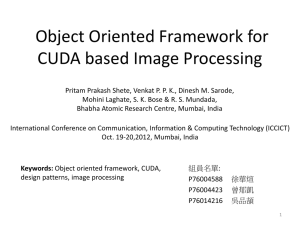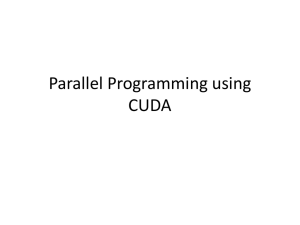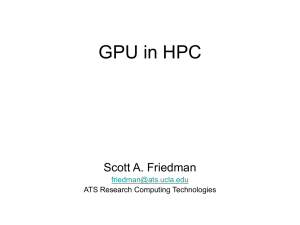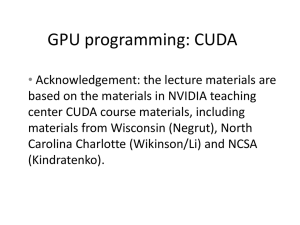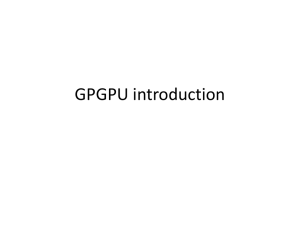CUDA programming - FSU Computer Science
advertisement
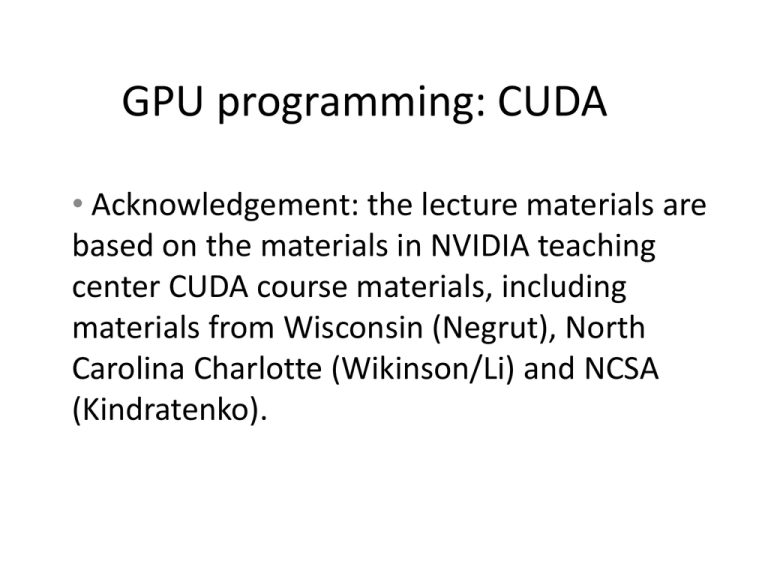
GPU programming: CUDA
• Acknowledgement: the lecture materials are
based on the materials in NVIDIA teaching
center CUDA course materials, including
materials from Wisconsin (Negrut), North
Carolina Charlotte (Wikinson/Li) and NCSA
(Kindratenko).
CUDA
• CUDA is Nvidia’s scalable parallel
programming model and a software
environment for parallel computing
– Lanugage: CUDA C, minor extension to C/C++
• Let the programmer focus on parallel algorithms not
parallel programming mechanisms.
– A heterogeneous serial-parallel programming
model
• Desinged to program heterogeneous CPU+GPU systems
– CPU and GPU are separate devices with separate memory
Heterogeneous programming with
CUDA
• Fork-join model: CUDA program = serial code +
parallel kernels (all in CUDA C)
• Serial C code executes in a host thread (CPU thread)
• Parallel kernel code executes in many device threads (GPU
threads)
CUDA kernel
• Kernel code is regular C code except that it will
use thread ID (CUDA built-in variables) to
make different threads operate on different
data
– Also variables for the total number of threads
• When a kernel is reached in the code for the
first time, it is launched onto GPU.
CPU and GPU memory
• CPU and GPU have different
memories:
• CPU memory is called host
memory
• GPU memory is called device
memory
– Implication:
• Explicitly transfer data from CPU
to GPU for GPU computation, and
CPU
CPU main memory
Copy from
CPU to
GPU
Copy from
GPU to
CPU
GPU global memory
• Explicitly transfer results in GPU
memory copied back to CPU
memory
GPU
Basic CUDA program structure
int main (int argc, char **argv ) {
1. Allocate memory space in device (GPU) for data
2. Allocate memory space in host (CPU) for data
3. Copy data to GPU
4. Call “kernel” routine to execute on GPU
(with CUDA syntax that defines no of threads and their physical structure)
5. Transfer results from GPU to CPU
6. Free memory space in device (GPU)
7. Free memory space in host (CPU)
return;
}
1. Allocating memory in GPU (device)
• The cudaMalloc routine:
int size = N *sizeof( int);
// space for N integers
int *devA, *devB, *devC; // devA, devB, devC ptrs
cudaMalloc( (void**)&devA, size) );
cudaMalloc( (void**)&devB, size );
cudaMalloc( (void**)&devC, size );
• 2. Allocating memory in host (CPU)?
– The regular malloc routine
3. Transferring data from/to host (CPU)
to/from device (GPU)
• CUDA routine cudaMemcpy
cudaMemcpy( devA, &A, size, cudaMemcpyHostToDevice);
cudaMemcpy( devB, &B, size, cudaMemcpyHostToDevice);
DevA and devB are pointers to destination in device (return
from cudaMalloc and A and B are pointers to host data
3. Defining/invoking kernel routine
• Define: CUDA specifier __global__
#define N 256
__global__ void vecAdd(int *A, int *B, int *C) { // Kernel definition
int i = threadIdx.x;
C[i] = A[i] + B[i];
}
Each thread performs one pair-wise addition:
int main() {
// allocate device memory &
// copy data to device
// device mem. ptrs devA,devB,devC
vecAdd<<<1, N>>>(devA,devB,devC);
…
}
Thread 0: devC[0] = devA[0] + devB[0];
Thread 1: devC[1] = devA[1] + devB[1];
Thread 2: devC[2] = devA[2] + devB[2];
This is the fork-join statement in Cuda
Notice the devA/B/C are device memory
pointer
CUDA kernel invocation
• <<<…>>> syntax (addition to C) for kernel calls:
myKernel<<< n, m >>>(arg1, … );
• <<< … >>> contains thread organization for this
particular kernel call in two parameters, n and m:
– vecAdd<<<1, N>>>(devA,devB,devC): 1 dimension block
with N threads
• Threads execute very efficiently on GPU: we can have fine-grain
threads (a few statements)
– More thread organization later
• arg1, … , -- arguments to routine myKernel typically
pointers to device memory obtained previously from
cudaMallac.
5. Transferring data from device (GPU)
to host (CPU)
• CUDA routine cudaMemcpy
cudaMemcpy( &C, dev_C, size, cudaMemcpyDeviceToHost);
– dev_C is a pointer in device memory and C is a
pointer in host memory.
6. Free memory space
• In “device” (GPU) -- Use CUDA cudaFree routine:
cudaFree( dev_a);
cudaFree( dev_b);
cudaFree( dev_c);
• In (CPU) host (if CPU memory allocated with malloc) -- Use
regular C free routine:
free( a );
free( b );
free( c );
Complete CUDA examples
•
•
•
•
See vecadd.cu
Compare the speed of vecadd.c and vecadd.cu
See also vec_complex.c and vec_complex.cu
Compiling CUDA programs
– Use the gpu.cs.fsu.edu (gpu1, gpu2, gpu3)
– Naming convention .cu programs are CUDA
programs
– NVIDIA CUDA compiler driver: nvcc
– To compile vecadd.cu: nvcc –O3 vecadd.cu
Compilation process
• nvcc “wrapper” divides
code into host and device
parts.
nvcc
• Host part compiled by
regular C compiler
• Device part compiled by
NVIDIA “ptxas” assembler
• Two compiled parts
combined into one
executable
gcc
ptxas
executable
Executable file a “fat” binary” with both
host and device code


